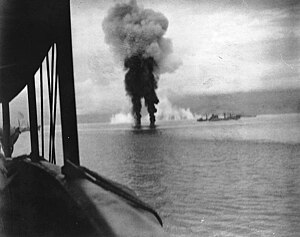
Back معركة غوادالكانال البحرية Arabic Batalla naval de Guadalcanal AST Quadalkanal dəniz döyüşü Azerbaijani قوادالکانال دؤیوشو AZB Морска битка при Гуадалканал Bulgarian Bitva u Guadalcanalu Czech Søslaget ved Guadalcanal Danish Seeschlacht von Guadalcanal German Batalla naval de Guadalcanal Spanish نبرد دریایی گوادالکانال Persian
| Naval Battle of Guadalcanal | |||||||
|---|---|---|---|---|---|---|---|
| Part of the Pacific Theater of World War II | |||||||
 Smoke rises from two Japanese aircraft shot down off Guadalcanal on 12 November 1942; ship at right is USS Betelgeuse. | |||||||
| |||||||
| Belligerents | |||||||
|
|
| ||||||
| Commanders and leaders | |||||||
| Strength | |||||||
|
First night (12/13 Nov):
Second night (14/15Nov):
|
First night:
14 Nov:
Second night:
| ||||||
| Casualties and losses | |||||||
|
First phase (13 Nov):
Second phase (15 Nov):
Plus (13–15 Nov):
|
13 Nov:
14 Nov:
15 Nov:
Plus:
| ||||||
The Naval Battle of Guadalcanal, sometimes referred to as the Third and Fourth Battles of Savo Island, the Battle of the Solomons, The Battle of Friday the 13th, The Night of the Big Guns, or, in Japanese sources, the Third Battle of the Solomon Sea (第三次ソロモン海戦, Dai-san-ji Soromon Kaisen), took place from 12 to 15 November 1942 and was the decisive engagement in a series of naval battles between Allied (primarily American) and Imperial Japanese forces during the months-long Guadalcanal campaign in the Solomon Islands during World War II. The action consisted of combined air and sea engagements over four days, most near Guadalcanal and all related to a Japanese effort to reinforce land forces on the island. The only two U.S. Navy admirals to be killed in a surface engagement in the war were lost in this battle.
Allied forces landed on Guadalcanal on 7 August 1942 and seized an airfield, later called Henderson Field, that was under construction by the Japanese military. There were several subsequent attempts to recapture the airfield by the Imperial Japanese Army and Navy using reinforcements delivered to Guadalcanal by ship, efforts which ultimately failed. In early November 1942, the Japanese organized a transport convoy to take 7,000 infantry troops and their equipment to Guadalcanal to attempt once again to retake the airfield. Several Japanese warship forces were assigned to bombard Henderson Field with the goal of destroying Allied aircraft that posed a threat to the convoy. Learning of the Japanese reinforcement effort, U.S. forces launched aircraft and warship attacks to defend Henderson Field and prevent the Japanese ground troops from reaching Guadalcanal.
In the resulting battle, both sides lost numerous warships in two extremely destructive surface engagements at night. Nevertheless, the U.S. succeeded in turning back attempts by the Japanese to bombard Henderson Field with battleships. Allied aircraft also sank most of the Japanese troop transports and prevented the majority of the Japanese troops and equipment from reaching Guadalcanal. Thus, the battle turned back Japan's last major attempt to dislodge Allied forces from Guadalcanal and nearby Tulagi, resulting in a strategic victory for the U.S. and its allies and deciding the ultimate outcome of the Guadalcanal campaign in their favor. The Japanese decided on the evacuation of Guadalcanal the following month, which they completed by early February 1943.
Guadalcanal was the last major naval battle in the Pacific War for the next one-and-a-half years, until the Battle of the Philippine Sea. It was one of the costliest naval battles of the Second World War in terms of lives lost.
- ^ Kirishima, Nagara, and 4 destroyers return after the first night's engagement
- ^ Frank, Guadalcanal, p. 490; and Lundstrom, Guadalcanal Campaign, p. 523.
- ^ Frank, Guadalcanal, p. 490. Frank's breakdown of Japanese losses includes only 450 soldiers on the transports, "a figure no American flier would have believed", p. 462, but cites Japanese records for this number.
Miller, in Guadalcanal: The First Offensive (1948) Archived 23 July 2010 at the Wayback Machine, cites "USAFISPA, Japanese Campaign in the Guadalcanal Area, 29–30, estimates that 7,700 troops had been aboard, of whom 3,000 drowned, 3,000 landed on Guadalcanal, and 1,700 were rescued." Frank's number is used here instead of Miller. Aircraft losses from Lundstrom, Guadalcanal Campaign, p. 522.